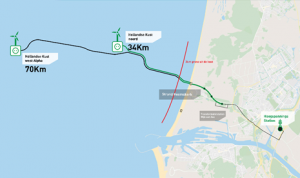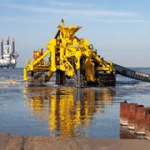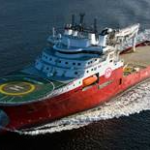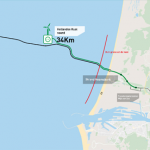Jan De Nul connects TenneT’s electricity network and continues to invest in its offshore installation fleet
 On 17 November 2022, Jan De Nul Group completed the first part of the cable installation works to connect the wind farms Hollandse Kust (noord) and (west Alpha) to the Dutch mainland. Also the 220kV high-voltage tests of both sea and land cables for Hollandse Kust (noord) were successfully completed, from the onshore substation to the substation located 18km offshore.
On 17 November 2022, Jan De Nul Group completed the first part of the cable installation works to connect the wind farms Hollandse Kust (noord) and (west Alpha) to the Dutch mainland. Also the 220kV high-voltage tests of both sea and land cables for Hollandse Kust (noord) were successfully completed, from the onshore substation to the substation located 18km offshore.
Also on 24 November, Jan De Nul signed a contract with Global Marine Systems for the acquisition of the OSV Global Symphony. This marks a further investment in the offshore installation capacities of the Luxembourg-based maritime contractor. Wouter Vermeersch, Manager Offshore Cables at Jan De Nul Group, says, “The Hollandse Kust (noord) and (west Alpha) project showcases our expertise in cable installation works. Jan De Nul has a very modern cable installation fleet, with three large cable installation vessels, supporting trenchers and amphibious cranes. Our investment in an additional OSV, that in legacy of her history and track record will be renamed as Symphony, underlines Jan De Nul Group’s vision to offer the world a solution to the badly needed energy transition. With the success in the Netherlands and the investment in its offshore installation fleet, Jan De Nul validates its expertise in and resolute commitment to this energy transition.”
For Hollandse Kust (noord) Jan De Nul deployed a diverse fleet of in-house cable installation equipment. The cable installation vessel Isaac Newton installed the cables on the seabed. In addition, Jan De Nul used several remote-controlled underwater trenchers and amphibious cranes in the surf zone to bury and protect the cable in the seabed. The Moonfish (picture) is one of these trenchers, a Jan De Nul design tailored to the needs of this project. In Spring, the cable installation vessel Isaac Newton collected the first lot of 90km of sea cable from our consortium partner LS Cable & System in South Korea. After arriving in the Netherlands, the Isaac Newton installed four different sea cables, starting from the beach.
- Two cables were laid in one length on the seabed, all the way to the transformer station of Hollandse Kust (noord).
- For the connection to the transformer station of Hollandse Kust (west Alpha), the Isaac Newton installed the first 8km
- Next, the trencher Moonfish set to work, burying and protecting the sea cables in the seabed. In the first phase, the Moonfish buried the first section of the two Hollandse Kust (noord) sea cables in the seabed, from the beach up to 3 kilometres offshore, at a depth of about 6 to 8m.
- From 3km offshore, the submarine vehicle UTV1200 took over, laying the cable up to the transformer station. This ‘offshore socket’ is located 18km off the Dutch coast.
- After the summer high season, in October, Jan De Nul completed this first installation campaign by burying the two cable sections for Hollandse Kust (west Alpha) from the beach up to 3km offshore.
The Moonfish on wide tracks has been designed and made to lay cables underwater, up to 35m deep. With its long metal sword and powerful water jets, the Moonfish buries the cables in the seabed. A floating water pipe pumps water to the powerful water jets on the Moonfish’s long metal sword. With this, the Moonfish makes a deep trench in the seabed, where it simultaneously lays the cable at a depth of up to 8m. The trench is then immediately backfilled. As a result, the cables are safely protected against future coastal erosion. Ward Mertens, Project Manager for Jan De Nul Group, says, “Preparations started this year on 1 March, immediately after the storm season. Our daughter company Soetaert installed four long cofferdams for the sea cable’s reception pits. Simultaneously, we dredged away the sand dunes just off the coast to clear the path for the Moonfish. The Moonfish set to work at the end of May. Controlled from the jack-up installation vessel just off the coast, the machine drove up to the beach. With the onset of a beautiful sunset, the machine got moving for the first time and buried the first sea cable at a depth of 8m. A fantastic moment after almost 2 years of engineering!”
The second and third installation campaigns will take place in the first half of 2023. In total, Jan De Nul is installing four sea cables in three installation campaigns. These sea cables will connect the transformer stations of the two wind farms Hollandse Kust (noord) and (west Alpha) to the mainland. Each transformer station will receive two cables, all together accounting for a total cable length of 235km. Jan De Nul still needs to install two more cable sections to connect the future wind farm Hollandse Kust (West Alpha) to the grid. Jan De Nul’s cable installation vessel Connector will collect the first in South Korea, transport it to the Netherlands and then install it. The Isaac Newton will again be deployed for transporting and installing the final sea cable section.
The Symphony will support Jan De Nul in its cable installation activities. Built in 2011, the Symphony has an extensive 1,400m² deck space and is amongst others equipped with two 150HP work class ROV systems and a 150t AHC crane. Thanks to the design of the vessel, the Symphony can operate in higher seastates. The Symphony will predominantly be used to support our cable installation activities and will operate as a dedicated Trenching Support Vessel. Our recently delivered state-of-the-art newbuilt trencher Swordfish will be installed on board of the Symphony by the first quarter of 2023. Thanks to this and other investments throughout the past years, Jan De Nul Group operates today a very modern and balanced offshore fleet, comprising this offshore support vessel, two offshore jack-up installation vessels, three floating crane installation vessels, three cable-lay vessels, five rock installation vessels and two multipurpose vessels.
Map:









